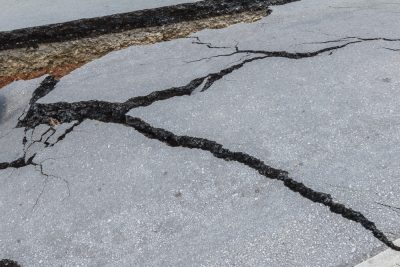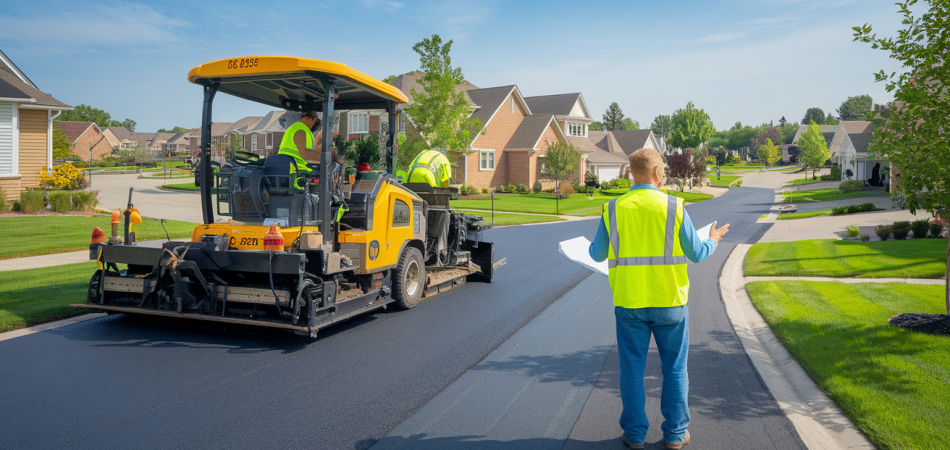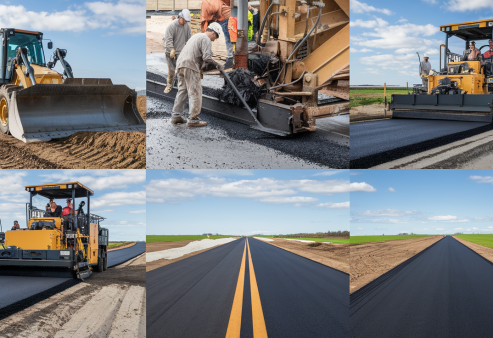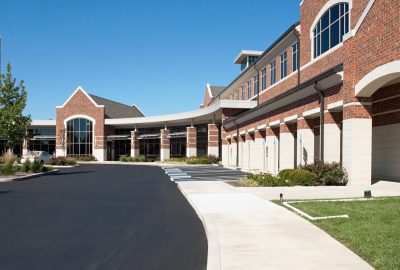Avoiding the most common asphalt paving mistakes from the start helps prevent costly repairs and premature deterioration. Issues like improper base preparation, incorrect asphalt thickness, and poor drainage lead to cracks and potholes far sooner than expected.
TurnKey Asphalt prioritizes careful planning, top-quality materials, and expert craftsmanship to ensure strong, long-lasting surfaces. Addressing these common mistakes upfront keeps paved surfaces smooth, durable, and cost-effective for years. Want to make sure your paving project starts off right? Reach out to us today for expert advice and reliable solutions.
Why do Asphalt Paving Mistakes Happen?

Errors in asphalt paving usually result from inadequate planning, inexperience, miscommunication, and ignoring site conditions. These generate pavement weaknesses that result in high repair or replacement costs. Nipping these frequent issues in the bud ensures long-term outcomes.
Lack of Planning and Preparation
An asphalt surface is structured with a solid basis. Floor analysis, classification, and accurate cleaning are the necessary processes to avoid uneven settings. There is an accurate asphalt mixture that is also very important—the factors that are heavier for heavier flow for mixtures are harder, while areas may repeat the freezing and defrosting cycles that require flexibility.
Temperature adjustment is also very important. Sugar must be at the beach from 275 °F to 300 °F for accurate installation. There is no appropriate compression, and airbags are created, causing surface incidents on the road.
Choosing the Wrong Contractor
Selecting an experienced contractor ensures proper soil testing, grading, and base preparation. Signs of poor preparation, such as standing water or uneven surfaces, indicate potential long-term issues. A well-prepared base directly impacts asphalt longevity, preventing premature failure.
Poor Communication and Coordination
Miscommunication creates expensive errors, like placing the wrong asphalt mixture. Busier highways require a tighter mixture, and colder climates necessitate a more elastic one. Getting advice from asphalt specialists ensures that appropriate specifications are adopted.
Some of the common choices are dense-graded asphalt for roads and stone matrix asphalt for heavy-duty sections.
Ignoring Site Assessment Results
Adequate site inspection takes into account the temperature, weather, and traffic load. Asphalt needs to be placed between 50°F and 90°F when the weather is dry to prevent substandard curing. Proper material temperature is maintained with equipment like infrared thermometers, which helps to improve durability.
What Are Common Asphalt Paving Mistakes?
Asphalt paving requires attention and consideration for every detail to produce a durable, high-quality surface. Poor installation leads to premature failure, costly repairs, and higher maintenance. Follow these steps to avoid typical mistakes and improve results.
1. Ignoring Proper Base Preparation
A stable base prevents premature pavement failure. Asphalt thickness must match usage needs.
- Residential driveways: 2-3 inches
- Light-use parking lots: 3 inches
- Heavy-use parking lots: 4 inches or more
Weak or unstable soil requires stabilization to prevent cracking. Too-thin asphalt wears out quickly, while an overly thick application wastes resources.
2. Using Incorrect Asphalt Mix Design
Choosing the correct mix ensures durability. Driveways need a minimum 2% slope to prevent water pooling. Regular maintenance, such as clearing drains and resealing every two to three years, extends the surface lifespan.
3. Neglecting Asphalt Temperature Control
Asphalt must be installed at the right temperature to bond correctly. If applied when too cold or during rainy weather, it weakens over time. Checking weather conditions and using temperature monitoring tools improve installation quality.
4. Failing to Achieve Adequate Compaction
Compaction strengthens asphalt through air pocket elimination. Without it, surfaces develop cracks. Vibratory rollers ensure even density, preventing defects like raveling or depressions.
5. Applying Improper Pavement Thickness
Proper thickness depends on the expected use. Thin asphalt fails under pressure, while excessive thickness increases costs without added benefits. Following recommended guidelines balances durability and efficiency.
6. Overlooking Effective Drainage Solutions
Water damage accelerates asphalt breakdown. Slopes should be at least 2% to ensure runoff. Regular maintenance prevents debris buildup and blockages that can cause pavement deterioration.
7. Ignoring Weather Conditions
Paving in cold or wet conditions weakens asphalt. Scheduling work in favorable weather improves pavement longevity and performance.
8. Delaying Timely Repairs
Small cracks and potholes develop further if not treated. Immediate repairs with crack fillers or patching compounds avoid deterioration and expensive replacements.
9. Taking Material Shortcuts
Low-quality materials may be more affordable in the short term but require frequent repairs. Money spent on good-quality asphalt and additives pays off in the long run.
10. Improper Joint Construction
Joints are weak points where cracks often form. Smooth, water-resistant joints result from proper construction methods, such as overlapping edges and thorough compaction.
Preparation Phase Mistakes
Skipping essential preparation steps leads to costly repairs and shortens pavement lifespan. Careful planning and experienced contractors prevent these issues.
Skipping Soil Testing
Unstable soil causes cracking and potholes. Testing soil stability ensures a solid foundation for long-lasting asphalt surfaces.
Neglecting Proper Grading
Proper grading prevents water accumulation. Well-calibrated grading equipment ensures even surfaces, reducing erosion risks.
Insufficient Base Compaction
A compacted base evenly distributes weight, preventing dips and deformations. Skilled operators using advanced equipment create a solid foundation.
Execution Phase Mistakes
Even with solid preparation, mistakes during execution compromise pavement quality. Proper techniques and equipment usage ensure durable results.
Getting Asphalt Compaction Right
Asphalt must be compacted hot (250°F–300°F) to form firm bonds. The application of vibratory rollers removes air pockets, eliminating early cracks and potholes.
Applying Asphalt in the Wrong Weather
Cold or damp conditions inhibit the proper curing of asphalt, causing premature deterioration. Scheduling projects in moderate weather improves outcomes.
Dirty or Damaged Equipment
Poorly maintained tools cause defects like raveling, where aggregate separates from asphalt. Cleaning and inspecting equipment before use improves results.
Inconsistent Asphalt Spreading
Uneven application leads to depressions and water retention. Proper leveling and compaction ensure each layer bonds correctly.
How to Avoid Asphalt Paving Mistakes
Prevention of asphalt paving errors involves careful planning, competent application, and regular maintenance. Clean equipment and quality control ensure strong, long-lasting pavement.
-
Maintain Equipment Regularly
Regular checks and cleaning maintain equipment at its best, averting delays and quality problems in projects.
-
Hire Experienced Contractors
Trained contractors offer best practices, proper material selection, and quality control, reducing future repair costs.
-
Conduct Thorough Site Assessments
Assessing soil stability, drainage, and slope before paving prevents future problems. Regular inspections during and after installation catch imperfections early.
Consequences of Asphalt Paving Errors

Paving errors have long-lasting issues, both functional and cosmetic. Bad craftsmanship and wrong techniques commonly destroy roads, decreasing curb appeal and maintenance costs.
Here’s a closer examination of these issues.
Reduced Pavement Lifespan
Inadequate compaction and drainage permit water ingress, speeding up wear and tear. Advanced paving technologies like infrared monitoring improve precision.
Higher Repair Costs
Regular repairs accumulate over time. Asphalt mixtures with polymer enhancements improve flexibility and durability.
Safety Hazards
Uneven surfaces and poor joint construction create trip hazards and slippery conditions. Real-time monitoring tools ensure proper material placement.
Aesthetic Issues
Poor paving methods cause discoloration, tire marks, and uneven surfaces. Specialized paving equipment helps achieve a smoother, more even finish.
Avoid Costly Asphalt Mistakes with Smart Planning
Poor planning and low-quality materials lead to cracks, raveling, and costly repairs. Proper prep, expert execution, and routine maintenance keep asphalt surfaces strong and durable.
A well-installed asphalt surface not only improves curb appeal but also adds long-term value to your property. Investing in professional services helps prevent early wear and saves money over time. Let our experienced team help you make the right choice for lasting results. TurnKey Asphalt ensures your project is built to last. Contact us today for expert guidance and quality results!








 By TurnKey Asphalt
By TurnKey Asphalt  Jul 18, 2025
Jul 18, 2025 






